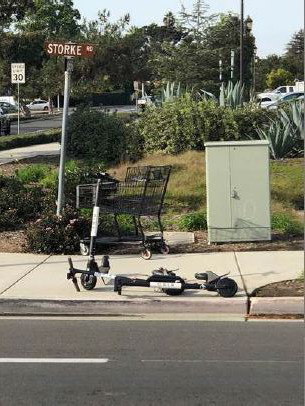Before the Ban: A Scooter Ride in Goleta
Author Finds “Shared-Mobility Devices” Easy to Use, Cost Effective

The electric scooters arrived in my neighborhood, on the rural fringes of Goleta, late last year. They were called controversial, a blight on the landscape, and even dangerous. While much was reported about their legality and their “better to beg for forgiveness than ask for permission” business launch, little was written about their day-to-day rideability and usefulness. Then, in December, the Goleta City Council voted unanimously to ban “shared on-demand motorized scooter operations” within city limits. The ban is viewed as a temporary measure until the city can write rules to regulate the fast-growing industry.
Before the ban, there was a “nest” of new scooters at the end of my block. If the nest was empty, I could use a smartphone app to locate the closest scooter provided by two main providers, Bird and Lime. (Their rideshare apps resemble those of Lyft and Uber.) There was a quick sign-up process. Lime scanned my driver’s license; Bird didn’t. I entered my credit card info, accepted terms and conditions, and lastly scanned the scooter’s QR code. There was an audible confirmation, the scooter lit up, and it was now unlocked. I pushed off, squeezed the accelerator button, and away I went.
The scooters had nice bright lights, front and rear, and Lime scooters had a large LCD speedometer and battery meter. I found that they can hit 20 mph downhill and around half that going uphill. Scooter riders are motorists, not pedestrians, and they should use bike lanes, obey traffic signals, and stay off sidewalks. It is recommended that a rider wear a helmet. Unfortunately, many riders ignore these rules of the road. To me, riding the scooters was fun, like riding a bike with zero effort.
When I got to where I was going, I would find a safe place to park the scooter — they come with kickstands — and lock it with the app to end my ride. The app required me to snap a photo to prove I had safely parked the scooter so that it was not in anybody’s way. My most recent ride was two miles long. It took 11 minutes and cost $2.65. Lime and Bird both charge $1 to unlock scooters and $0.15 and $0.20 per minute, respectively. If you need to temporarily park the scooter while you’re inside a store, for example, the app also allows you to pause your ride, keeping the scooter locked and unavailable to others.
Riding a scooter cost more than I would spend on gas if I used my car for the same trip. But that’s not the point. And not everyone has a car. The way I see it, scooters can help mitigate carbon emissions, fill in the gaps between existing public transport, help people make a few extra bucks by taking them home to charge them, and maybe even reduce the number of cars on the road. I found them easy to use, cost-effective, and available pretty much on demand. I hope they become a permanent part of our transportation options.



